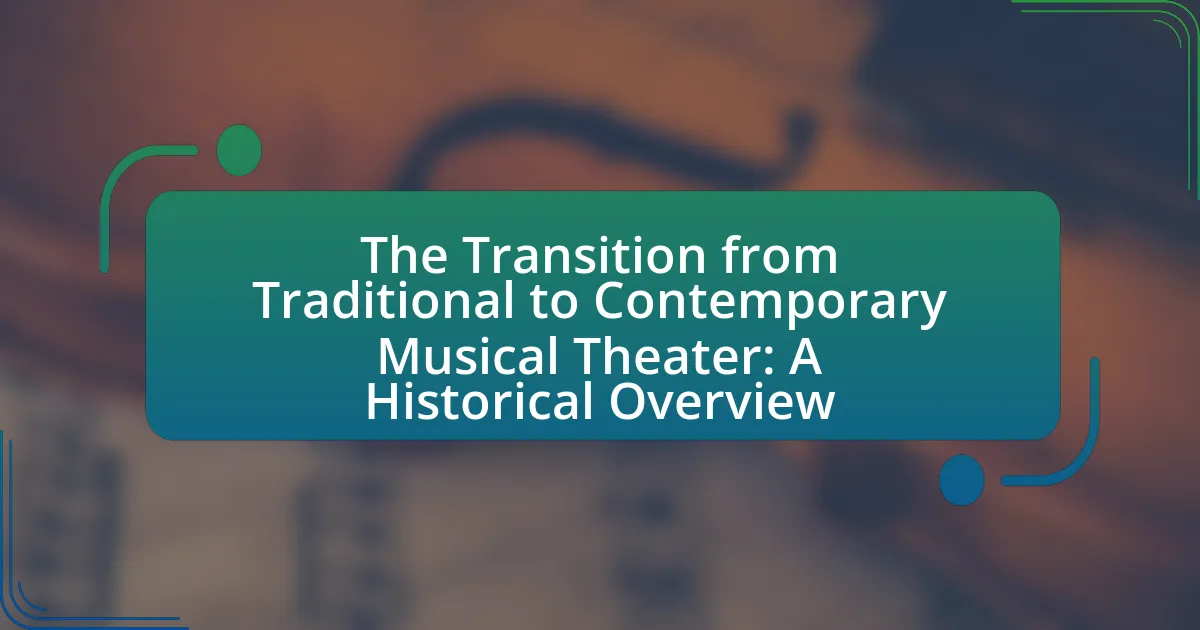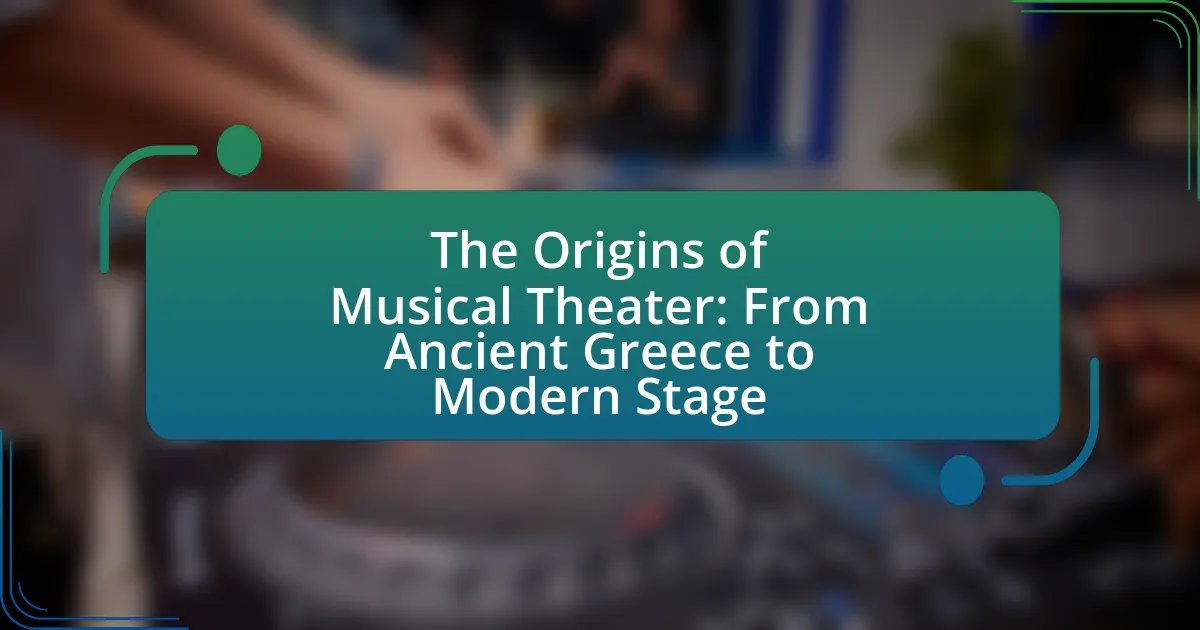The globalization of musical theater refers to the integration of diverse cultural influences and styles from around the world into American productions. This article examines how international elements, such as musical styles and storytelling techniques from Asian, African, and Latin American cultures, have enriched American musical theater, exemplified by successful shows like “The Lion King” and “Hamilton.” It also explores the historical roots of globalization in musical theater, the impact of immigration, and the challenges of cultural appropriation and homogenization. Additionally, the article highlights best practices for incorporating global influences while maintaining authenticity and local identity in productions.

What is the Globalization of Musical Theater?
The globalization of musical theater refers to the process by which musical theater has transcended national boundaries, incorporating diverse cultural influences and styles from around the world. This phenomenon is evident in the adaptation of international works, such as the incorporation of Asian, African, and Latin American musical elements into American productions, which has enriched the storytelling and musical composition. For instance, the success of shows like “The Lion King,” which integrates African music and dance, exemplifies how global influences can shape and enhance American musical theater. Additionally, the rise of international collaborations and co-productions has further facilitated this exchange, allowing for a blending of artistic traditions and broadening the audience’s experience.
How has globalization influenced the evolution of musical theater?
Globalization has significantly influenced the evolution of musical theater by facilitating the exchange of cultural elements across borders. This exchange has led to the incorporation of diverse musical styles, storytelling techniques, and performance practices from various cultures into American productions. For instance, the success of shows like “The Lion King,” which integrates African musical traditions and aesthetics, exemplifies how global influences can reshape narratives and artistic expressions in musical theater. Additionally, the rise of international collaborations and co-productions has allowed for a blending of artistic visions, further enriching the genre. The impact of globalization is evident in the increasing presence of non-Western themes and the adaptation of global stories, reflecting a more interconnected world in the realm of musical theater.
What are the key international elements that have been integrated into American musical theater?
Key international elements integrated into American musical theater include diverse musical styles, storytelling techniques, and cultural themes. For instance, the influence of operetta from Europe introduced sophisticated melodies and structures, while jazz and blues from African American culture added rhythmic complexity and emotional depth. Additionally, the incorporation of Latin rhythms and dance styles, as seen in productions like “West Side Story,” reflects the impact of Hispanic culture. The adaptation of global narratives, such as those from Asian and African traditions, has also enriched American storytelling, exemplified by shows like “The King and I” and “The Lion King.” These elements demonstrate how American musical theater has evolved through a blend of international influences, creating a rich and varied artistic landscape.
How do cultural exchanges shape the narratives and themes in American productions?
Cultural exchanges significantly shape the narratives and themes in American productions by introducing diverse perspectives and storytelling techniques. For instance, the incorporation of elements from Asian, African, and Latin American cultures has led to the creation of hybrid genres and innovative narratives, as seen in productions like “The King and I,” which blends Western and Eastern storytelling traditions. Additionally, the influence of international musical styles, such as the rhythms of Afro-Caribbean music in “In the Heights,” enriches the thematic depth and emotional resonance of American musicals. This cross-pollination not only broadens the appeal of these productions but also reflects the multicultural fabric of contemporary American society, demonstrating how cultural exchanges foster inclusivity and creativity in the performing arts.
Why is understanding the globalization of musical theater important?
Understanding the globalization of musical theater is important because it reveals how diverse cultural influences shape artistic expression and audience engagement. The integration of international styles and narratives enriches American productions, making them more relatable and appealing to a global audience. For instance, the incorporation of elements from Asian, African, and Latin American traditions has led to innovative storytelling techniques and musical styles, as seen in productions like “The Lion King,” which blends African rhythms and storytelling with Broadway flair. This cross-cultural exchange not only enhances the artistic quality of musical theater but also fosters greater cultural appreciation and understanding among audiences worldwide.
What impact does globalization have on audience perceptions of musical theater?
Globalization significantly alters audience perceptions of musical theater by introducing diverse cultural elements and narratives. This exposure to varied artistic expressions enhances audience appreciation for different styles and themes, leading to a broader understanding of global issues and cultural contexts. For instance, the incorporation of non-Western musical traditions and storytelling techniques in productions like “The Lion King” and “Miss Saigon” has expanded the audience’s expectations and engagement with the genre. Furthermore, studies indicate that audiences are increasingly drawn to productions that reflect multicultural influences, as seen in the success of shows like “Hamilton,” which blends hip-hop with traditional musical theater. This shift demonstrates that globalization not only diversifies the content of musical theater but also enriches the audience’s experience and perception of the art form.
How does globalization affect the diversity of stories told in American musical theater?
Globalization significantly enhances the diversity of stories told in American musical theater by introducing a wide array of cultural narratives and artistic styles from around the world. This influx of international influences allows for the incorporation of varied themes, characters, and storytelling techniques, reflecting a broader spectrum of human experiences. For instance, productions like “The Lion King,” which draws on African storytelling traditions, and “In the Heights,” which showcases Latinx culture, exemplify how globalization has led to a richer tapestry of narratives in American musical theater. Additionally, the collaboration between American artists and international creators fosters innovative works that resonate with diverse audiences, further expanding the range of stories presented on stage.

What are the historical roots of globalization in musical theater?
The historical roots of globalization in musical theater can be traced back to the early 20th century when American musical theater began to incorporate diverse cultural influences. The introduction of European operettas and the influence of African American musical traditions, such as jazz and blues, significantly shaped the genre. For instance, the success of shows like “Show Boat” in 1927 highlighted the integration of African American narratives and music into mainstream productions, reflecting broader societal changes and cultural exchanges. Additionally, the post-World War II era saw an increase in international collaborations and the adaptation of foreign works, further embedding global elements into American musical theater. This evolution illustrates how musical theater has historically served as a platform for cultural dialogue and exchange, paving the way for the globalization seen in contemporary productions.
How did early American musical theater reflect international influences?
Early American musical theater reflected international influences through the incorporation of diverse musical styles, theatrical traditions, and cultural narratives from Europe and other regions. For instance, the influence of European operettas and vaudeville can be seen in the structure and musicality of early American productions, which often blended elements from British and French theater. Additionally, the popularity of immigrant communities introduced various folk traditions and musical forms, such as Irish and African American music, which enriched the American theatrical landscape. This cross-cultural exchange not only shaped the content and style of early musicals but also laid the groundwork for the evolution of a uniquely American genre that continued to draw from global influences.
What role did immigration play in shaping the musical theater landscape?
Immigration significantly shaped the musical theater landscape by introducing diverse cultural influences and artistic styles. The influx of immigrants, particularly in the late 19th and early 20th centuries, brought various musical traditions, languages, and storytelling techniques that enriched American theater. For instance, Jewish immigrants contributed to the development of Broadway through the creation of iconic musicals like “Fiddler on the Roof,” which reflects their cultural heritage. Additionally, the influence of Latinx, African American, and Asian communities has led to the incorporation of different musical genres, such as jazz, salsa, and hip-hop, into mainstream productions. This blending of cultural elements has resulted in a more dynamic and inclusive musical theater scene, showcasing the impact of immigration on the evolution of American productions.
How did Broadway become a melting pot of global musical styles?
Broadway became a melting pot of global musical styles through the integration of diverse cultural influences and the collaboration of international artists. The influx of immigrants to the United States, particularly in the late 19th and early 20th centuries, introduced various musical traditions, such as jazz, Latin rhythms, and folk music, which were incorporated into theatrical productions. Additionally, the success of shows like “West Side Story,” which fused classical music with Latin influences, exemplifies how Broadway embraced and adapted global styles. The globalization of media and the rise of technology further facilitated the exchange of musical ideas, allowing Broadway to continually evolve and reflect a wide array of cultural expressions.
What significant milestones mark the globalization of musical theater?
Significant milestones that mark the globalization of musical theater include the introduction of British musicals to Broadway in the 1980s, such as “Cats” and “Les Misérables,” which showcased international storytelling and production styles. The success of these shows led to a broader acceptance of diverse narratives and styles in American theater. Additionally, the rise of global theater festivals, such as the Edinburgh Festival Fringe, has facilitated cultural exchange and the introduction of international works to wider audiences. The adaptation of non-Western stories into musical formats, exemplified by “The Lion King,” which incorporates African music and themes, further illustrates the blending of global influences in American productions. These milestones collectively highlight the evolving landscape of musical theater as it embraces a more global perspective.
Which landmark productions exemplify the fusion of international influences?
Landmark productions that exemplify the fusion of international influences include “The Lion King,” “Miss Saigon,” and “West Side Story.” “The Lion King,” adapted from the Disney animated film, incorporates African music and storytelling traditions, showcasing a blend of Western and African cultural elements. “Miss Saigon,” based on Puccini’s opera “Madama Butterfly,” integrates Vietnamese cultural themes and music, reflecting the impact of Asian influences on Western musical theater. “West Side Story,” inspired by Shakespeare’s “Romeo and Juliet,” incorporates Latin music and dance, highlighting the cultural dynamics of New York City in the 1950s. These productions illustrate how international influences have shaped American musical theater, creating a rich tapestry of diverse cultural expressions.
How have international collaborations changed the production landscape?
International collaborations have significantly transformed the production landscape by fostering diverse artistic expressions and expanding market reach. These partnerships enable the blending of cultural elements, resulting in innovative productions that appeal to a global audience. For instance, the collaboration between British and American theater companies has led to successful adaptations of international works, such as “The Lion King,” which incorporates African musical styles and storytelling techniques. This cross-cultural exchange not only enhances the creative process but also increases the financial viability of productions by attracting wider demographics, as evidenced by the global box office success of shows that incorporate international influences.

How do contemporary American productions reflect global influences?
Contemporary American productions reflect global influences through diverse storytelling, multicultural casting, and the incorporation of international musical styles. Productions like “Hamilton” showcase a blend of hip-hop and traditional musical theater, drawing from various cultural narratives and historical contexts, which highlights the impact of global perspectives on American art. Additionally, shows such as “The Lion King” utilize African musical elements and storytelling techniques, demonstrating how global influences shape the thematic and aesthetic aspects of American theater. This integration of global elements not only broadens the appeal of these productions but also fosters a more inclusive representation of different cultures within the American theatrical landscape.
What are the current trends in musical theater that showcase globalization?
Current trends in musical theater that showcase globalization include the incorporation of diverse cultural narratives, the blending of musical styles from various countries, and the international collaboration of artists. Productions like “The Lion King,” which integrates African musical elements and storytelling traditions, exemplify this trend. Additionally, shows such as “Hamilton” reflect a fusion of hip-hop and traditional musical theater, appealing to a global audience while addressing universal themes. The rise of international co-productions, such as the collaboration between Broadway and West End productions, further illustrates the interconnectedness of global theater markets. These trends highlight how globalization enriches the storytelling and musical composition within the genre.
How do modern musicals incorporate diverse musical genres from around the world?
Modern musicals incorporate diverse musical genres from around the world by blending various cultural sounds and styles into their compositions and performances. This integration is evident in productions like “The Lion King,” which features African rhythms and melodies, and “In the Heights,” which incorporates Latin music elements such as salsa and hip-hop. Additionally, musicals like “Miss Saigon” and “Aladdin” draw from Asian and Middle Eastern musical traditions, respectively, showcasing a wide array of global influences. The use of these genres not only enriches the storytelling but also reflects the multicultural landscape of contemporary society, making the performances resonate with a broader audience.
What themes in contemporary musicals highlight global issues and perspectives?
Contemporary musicals often highlight themes such as immigration, social justice, and climate change, reflecting global issues and diverse perspectives. For instance, “In the Heights” addresses the immigrant experience and cultural identity in Washington Heights, showcasing the challenges and aspirations of the Latino community. Similarly, “Dear Evan Hansen” explores mental health and the impact of social media, resonating with a global audience facing similar issues. Additionally, “Hadestown” incorporates themes of economic disparity and environmental concerns, drawing parallels to contemporary global crises. These musicals not only entertain but also provoke thought and discussion on pressing global matters, illustrating the interconnectedness of today’s society.
How do international artists contribute to American musical theater?
International artists significantly enhance American musical theater by introducing diverse cultural perspectives, innovative storytelling techniques, and unique musical styles. Their contributions often lead to the creation of hybrid productions that blend traditional American elements with international influences, enriching the overall theatrical experience. For instance, the success of shows like “The Lion King,” which incorporates African musical traditions and storytelling, exemplifies how international artists can shape American productions. Additionally, the involvement of international talent in Broadway, such as Lin-Manuel Miranda’s “Hamilton,” which draws from various musical genres and cultural narratives, showcases the impact of global influences on American theater. This cross-cultural exchange not only broadens the appeal of musical theater but also fosters a more inclusive artistic landscape.
What roles do foreign composers and lyricists play in shaping American productions?
Foreign composers and lyricists significantly influence American productions by introducing diverse musical styles and cultural narratives. Their contributions enrich the American musical theater landscape, as seen with composers like Andrew Lloyd Webber and Claude-Michel Schönberg, whose works such as “Cats” and “Les Misérables” have become staples in American theater. These international artists bring unique perspectives and innovative storytelling techniques, which help to broaden the thematic scope of American productions. The integration of global musical elements fosters a more inclusive and varied artistic environment, reflecting the multicultural fabric of contemporary society.
How do international performers influence the style and presentation of musicals?
International performers significantly influence the style and presentation of musicals by introducing diverse cultural elements, performance techniques, and unique interpretations. Their participation often leads to the incorporation of varied musical styles, such as blending traditional Broadway with international genres like Bollywood or K-pop, which enriches the overall sound and aesthetic of productions. For instance, the success of “The Lion King” on Broadway, which features South African musical influences, demonstrates how international artistry can reshape audience expectations and enhance storytelling through cultural authenticity. Additionally, international performers often bring different acting methodologies and choreography styles, which can lead to innovative staging and character portrayals, as seen in productions like “Miss Saigon,” where Asian performers contributed to a more authentic representation of the narrative. This cross-cultural exchange not only broadens the appeal of musicals but also fosters a global dialogue within the theater community, ultimately transforming the landscape of American musical theater.

What challenges arise from the globalization of musical theater?
The globalization of musical theater presents challenges such as cultural appropriation, loss of local identity, and economic disparities. Cultural appropriation occurs when elements of one culture are used by another, often without understanding or respect, leading to tensions and accusations of exploitation. The loss of local identity arises as global influences overshadow traditional narratives and styles, diminishing the uniqueness of regional productions. Economic disparities manifest when larger, international productions dominate local markets, making it difficult for smaller, local theaters to compete and thrive. These challenges highlight the complexities of merging diverse cultural expressions within the musical theater landscape.
What cultural sensitivities must be considered in global productions?
Cultural sensitivities in global productions include understanding local customs, beliefs, and social norms. Productions must respect cultural symbols and avoid stereotypes that could offend specific communities. For instance, the portrayal of religious practices or traditional attire should be handled with care to prevent misrepresentation. Additionally, language differences necessitate accurate translations and culturally relevant adaptations to ensure the message resonates appropriately with diverse audiences. Research indicates that productions that engage local cultural consultants are more successful in navigating these sensitivities, as they provide insights that enhance authenticity and respect.
How can cultural appropriation be avoided in musical theater?
Cultural appropriation in musical theater can be avoided by ensuring authentic representation and collaboration with the cultures being depicted. This involves engaging artists, writers, and consultants from those cultures in the creative process, which fosters respect and understanding. For instance, productions like “The Lion King” have successfully incorporated African cultural elements by collaborating with African artists and cultural experts, ensuring that the portrayal is both respectful and accurate. Additionally, implementing educational programs about cultural sensitivity for creators and audiences can further mitigate appropriation risks, promoting awareness and appreciation rather than exploitation.
What are the potential pitfalls of homogenization in storytelling?
The potential pitfalls of homogenization in storytelling include the loss of cultural diversity and the dilution of unique narratives. When stories become homogenized, they often prioritize universal themes over specific cultural contexts, leading to a lack of representation and authenticity. This trend can result in audiences being presented with a narrow range of perspectives, which diminishes the richness of storytelling. For instance, in the context of musical theater, the predominance of Western narratives can overshadow local traditions and stories, as seen in the global success of productions like “Hamilton,” which, while innovative, may overshadow other cultural expressions. This homogenization can alienate audiences who seek relatable and diverse narratives, ultimately impacting the vibrancy and evolution of the art form.
How can American musical theater maintain its identity amidst globalization?
American musical theater can maintain its identity amidst globalization by emphasizing its unique cultural narratives and musical styles. This distinctiveness is rooted in the historical context of American experiences, such as the influence of jazz, blues, and folk traditions, which are integral to its storytelling. For instance, productions like “Hamilton” showcase American history through a contemporary lens, blending hip-hop with traditional musical theater elements, thereby reinforcing a uniquely American identity while engaging with global audiences. Additionally, fostering local talent and incorporating regional stories can further solidify its cultural relevance, ensuring that American musical theater remains a reflection of its diverse society amidst the global landscape.
What strategies can be employed to celebrate local culture while embracing global influences?
To celebrate local culture while embracing global influences in musical theater, one effective strategy is to incorporate local storytelling and traditional elements into productions that also feature international themes and styles. This approach allows for a fusion of local narratives with global musical forms, creating a unique theatrical experience that resonates with diverse audiences. For example, the Broadway production of “The Lion King” integrates African musical traditions and storytelling techniques while appealing to a global audience, demonstrating how local culture can enhance universal themes. Additionally, collaborations between local artists and international creators can foster cross-cultural exchanges, enriching the artistic landscape and promoting cultural appreciation.
How can productions balance authenticity with international appeal?
Productions can balance authenticity with international appeal by integrating culturally specific elements while ensuring universal themes resonate with diverse audiences. For instance, incorporating local storytelling traditions and musical styles can enhance authenticity, as seen in the success of “The Lion King,” which blends African musical influences with a universally relatable narrative. This approach allows productions to maintain their cultural roots while attracting a global audience, evidenced by the show’s international adaptations that respect local cultures while preserving core themes.
What are best practices for integrating global influences in musical theater?
Best practices for integrating global influences in musical theater include collaborating with international artists, incorporating diverse musical styles, and adapting narratives to reflect various cultural perspectives. Collaborating with international artists brings authentic voices and experiences, enhancing the production’s depth and authenticity. For example, the Broadway production of “The Lion King” successfully integrated African musical elements and storytelling techniques, showcasing the richness of its cultural origins. Incorporating diverse musical styles, such as blending traditional Asian instruments with Western orchestration, can create a unique soundscape that resonates with a broader audience. Additionally, adapting narratives to reflect various cultural perspectives allows for a more inclusive representation, as seen in the adaptation of “West Side Story,” which recontextualizes Shakespeare’s “Romeo and Juliet” within a Puerto Rican-American setting. These practices not only enrich the theatrical experience but also foster a greater understanding and appreciation of global cultures.
How can producers effectively collaborate with international artists?
Producers can effectively collaborate with international artists by leveraging technology for remote communication and project management. Utilizing platforms like Zoom and collaborative tools such as Google Workspace allows for seamless interaction across different time zones. Additionally, establishing clear agreements regarding creative vision, financial arrangements, and cultural sensitivities ensures mutual understanding and respect. Research indicates that successful international collaborations often involve regular feedback loops and cultural exchange, which enhance creativity and innovation in productions. For instance, the Broadway musical “The Lion King” incorporated African cultural elements through collaboration with South African artists, demonstrating the effectiveness of such partnerships in enriching the artistic outcome.
What resources are available for exploring global musical traditions in theater?
Resources available for exploring global musical traditions in theater include academic journals, ethnomusicology databases, and cultural organizations. Academic journals such as “The Journal of American Folklore” and “Ethnomusicology” provide peer-reviewed articles on various musical traditions and their theatrical applications. Ethnomusicology databases like the Smithsonian Folkways Recordings offer extensive collections of world music that can be integrated into theatrical performances. Additionally, cultural organizations such as the International Theatre Institute and the World Music Network promote global musical traditions through workshops, festivals, and educational resources, facilitating a deeper understanding of how these influences shape theater.




